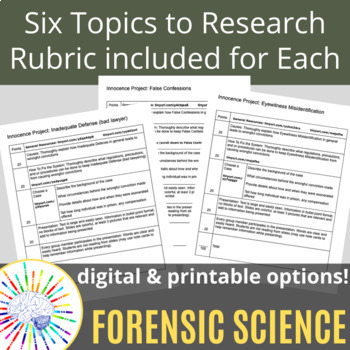BUNDLE: DNA Fingerprinting / DNA Evidence Forensics Notes, Activity, Project
- Google Drive™ folder

What educators are saying
Products in this Bundle (5)
Also included in
- High School Forensics Curriculum Bundle! Save on EVERY forensics product offered by Science of Curiosity. This is a GROWING bundle, with 76 products and counting! Includes ten full forensic units, six projects, review questions and assessments. Click HERE to see the detailed pacing guide that comesPrice $195.75Original Price $217.50Save $21.75
Description
Everything you need to teach DNA Fingerprinting as Forensic Evidence! NO PREP - Digital and Paper options for distance learning or in class! DNA Evidence teaching slides, notes sheets, DNA Fingerprinting Digital Model activity, and Project!
Teaching Slides: Forty one Google Slides!
Topics covered:
- What is DNA?
- Where can DNA be found at a crime scene?
- How is DNA Evidence collected and stored?
- History of DNA Evidence
- What is the value of DNA as evidence?
- Limitations of DNA evidence
- Steps for making a DNA Fingerprint
- Using DNA when there is no body
- Post Conviction DNA Testing - mention of the Innocence Project
Four page notes sheet: gives your students a chance to write down what they learn. Same notes sheets are also provided digitally in a Google Slide set for students to compete digitally!
Model DNA Fingerprinting: Your students will walk through the three steps of making a DNA Fingerprint. Then they use what they learned to create four DNA Fingerprints to solve a murder case!
All learning and instructions for the activity are included on the slides for them - truly no prep! Students can complete the activity on their own - or work in pairs.
Interactive Slides Activity includes:
- How are DNA Fingerprints Made?
- DNA Fingerprinting Notes
- DNA Fingerprinting Review
- Complete Answer Key
- Teacher Guide for how to use the activity
The Innocence Project: This project demonstrates the power of DNA as Forensic evidence. It will give students the chance to learn about the work of the Innocence Project: a non-profit group that helps people who have been wrongfully imprisoned. The Innocence Project has led to nearly 400 people being released from prison, some of them even from death row.
Most of the exonerations are due to post-conviction DNA testing, which was not available at the time of the trial. The Innocence Project obtains stored evidence from the case and, if possible, tests for DNA. If the DNA does not match the convicted individual - they must be innocent!
Their website lays out six different reasons that innocent people are convicted of crimes:
- Government Misconduct
- Bad Lawyering
- Improper Forensics
- Informants (snitches)
- False Confessions
- Faulty Eyewitnesses Testimony
Students will use the information from the Innocence Project website to learn about their given topic, the strategies for preventing wrongful convictions per their topic, and one actual Case of a person who was wrongfully convicted due to their topic. Students will create a Google Slide presentation with all of this information, and share it with the class.
As a wrap up activity, the class can watch a CBS news video (30 minutes long), the amazing story of Ronald Cotton, a man who was wrongfully convicted of rape, and freed with help of the Innocence Project.
Each part of this resource has printable and digital copies - so it can easily be modified for in class and virtual learning use.
What is included:
- Google Slides Introduction to the Innocence Project
- Digital Sign Up Sheet
- Printable Rubrics for all six topics
- Google Slides Templates for all six topics
- Digital and Printable Student Notes
- Digital and Printable Student Notes for the Case of Ronald Cotton - An amazing story! Watch it HERE!
- Comprehensive Teaching Guide - four pages of instructions on how to best use this resource! Easy to use, no guessing!
Unit Review Game - no prep, whole class, digital review game and study guide
Unit Test - 25 multiple choice questions on a fully editable, self grading Google Form
All resources are edible!
Click HERE to see the full Pacing Guide and know how this resource fits into the whole Forensic Science Curriculum.
Look for more Forensics resources to come! Follow Science of Curiosity to be notified when new products are available!
More Unit BUDLES from Science of Curiosity! All Complete Forensic Science Units:
- Forensics Tire Impression Evidence Unit: BUNDLE | Distance Learning
- Forensic Science Basics Unit BUNDLE Distance Learning
- Forensics Blood Spatter and Blood Evidence Unit BUNDLE- Notes, Activities, Lab
- Forensic DNA Fingerprinting / DNA Evidence BUNDLE Notes, Activity, Project
- Forensic Science Death Investigation BUNDLE - Autopsy, Decay, Bugs and Bones!
- Forensic Fingerprint Evidence BUNDLE
- Ballistics Evidence Unit BUNDLE
**Stay Curious!**






